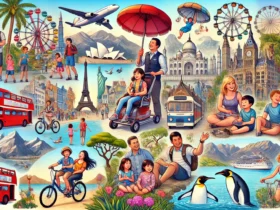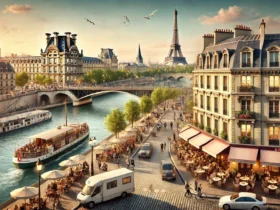Japan is a country of stunning contrasts, where ancient traditions coexist with cutting-edge technology. Its cities offer a blend of historical landmarks, modern attractions, and natural beauty. Here’s a guide to some of the best cities to visit in Japan.
1. Tokyo
Tokyo, the capital city, is a bustling metropolis known for its skyscrapers, shopping districts, and cultural landmarks. Visit the historic Senso-ji Temple in Asakusa, explore the trendy neighborhoods of Shibuya and Harajuku, and enjoy panoramic views from the Tokyo Skytree. Don’t miss the Meiji Shrine, the Imperial Palace, and the vibrant nightlife in Shinjuku. Tokyo Disneyland and DisneySea are also popular attractions.
2. Kyoto
Kyoto, the cultural heart of Japan, is famous for its well-preserved temples, traditional wooden houses, and beautiful gardens. Visit the iconic Fushimi Inari Shrine with its thousands of torii gates, the Golden Pavilion (Kinkaku-ji), and the serene Arashiyama Bamboo Grove. Explore the historic Gion district, known for its traditional teahouses and geisha culture. The Philosopher’s Path is a scenic walk, especially during cherry blossom season.
3. Osaka
Osaka is known for its modern architecture, vibrant nightlife, and delicious street food. Visit Osaka Castle, which offers insights into the city’s history, and explore the bustling Dotonbori district, famous for its neon lights and street food stalls. Universal Studios Japan is a major attraction, especially for families. Don’t miss the Umeda Sky Building for its futuristic design and stunning city views.
4. Hiroshima
Hiroshima is a city of historical significance, known for its Peace Memorial Park and Museum, which commemorate the atomic bombing during World War II. Visit the iconic Atomic Bomb Dome and the Children’s Peace Monument. Take a short ferry ride to Miyajima Island, home to the famous Itsukushima Shrine and its “floating” torii gate. Hiroshima is also known for its delicious okonomiyaki (savory pancakes).
5. Nara
Nara, located near Kyoto, is known for its historical treasures and friendly deer that roam freely in Nara Park. Visit Todai-ji Temple, home to the Great Buddha, and Kasuga Taisha Shrine with its thousands of lanterns. The Nara National Museum offers a rich collection of Buddhist art. Nara’s serene atmosphere and beautiful temples make it a peaceful retreat from the busier cities.
6. Sapporo
Sapporo, the largest city on the northern island of Hokkaido, is famous for its annual Snow Festival, which features impressive ice sculptures. Visit the Sapporo Beer Museum to learn about Japan’s brewing history, and relax in the scenic Odori Park. In winter, enjoy skiing and snowboarding at nearby resorts. Sapporo is also known for its fresh seafood and miso ramen.
7. Fukuoka
Fukuoka, located on the island of Kyushu, is known for its ancient temples, beaches, and modern shopping malls. Visit Fukuoka Castle and the surrounding Maizuru Park, especially during cherry blossom season. The city’s food stalls (yatai) offer a variety of local dishes, including Hakata ramen. Explore the bustling Tenjin district for shopping and entertainment.
8. Kanazawa
Kanazawa is known for its well-preserved Edo-period districts, art museums, and beautiful gardens. Visit Kenrokuen Garden, one of Japan’s most famous gardens, and explore the historic Nagamachi samurai district. The 21st Century Museum of Contemporary Art offers unique exhibits. Kanazawa Castle and the Higashi Chaya geisha district are also must-see attractions.
9. Yokohama
Yokohama, located just south of Tokyo, is known for its waterfront attractions and cosmopolitan atmosphere. Visit the Minato Mirai district, home to the Landmark Tower and the Cosmo Clock 21 Ferris wheel. Explore the historic Red Brick Warehouse, now a shopping and dining complex, and relax in Yamashita Park. Yokohama Chinatown is one of the largest in the world and offers a variety of delicious Chinese cuisine.
10. Nagasaki
Nagasaki, located on the island of Kyushu, has a rich history influenced by international trade. Visit the Nagasaki Peace Park and Atomic Bomb Museum to learn about the city’s history during World War II. Explore Glover Garden, which features Western-style homes from the 19th century, and visit the beautiful Oura Church. The city’s vibrant Chinatown and Dutch Slope are also worth exploring.
FAQs
Q: What is the best time to visit these cities in Japan?
A: The best time to visit Japan is during the spring (March to May) for cherry blossoms and the fall (September to November) for autumn foliage. Summer (June to August) can be hot and humid, but it’s a great time for festivals. Winter (December to February) offers unique experiences like skiing in Hokkaido and the Sapporo Snow Festival.
Q: How can I travel between these cities?
A: Japan has an extensive and efficient transportation network, including the Shinkansen (bullet train) that connects major cities like Tokyo, Kyoto, Osaka, and Hiroshima. Domestic flights are also available for longer distances, such as traveling to Hokkaido or Kyushu. Regional trains, buses, and rental cars are options for exploring more remote areas.
Q: What are some must-try foods in these cities?
A: Each city has its culinary specialties. In Tokyo, try sushi, tempura, and ramen. Kyoto is known for kaiseki (traditional multi-course meal) and matcha (green tea) sweets. Osaka offers street food like takoyaki (octopus balls) and okonomiyaki. Hiroshima is famous for its layered okonomiyaki. Nara has traditional mochi sweets. Sapporo is known for its miso ramen and seafood. Fukuoka is famous for Hakata ramen. Kanazawa offers fresh seafood and traditional sweets. Yokohama has a variety of international cuisine, including Chinese dishes in Chinatown. Nagasaki is known for champon (seafood noodle soup) and castella (sponge cake).
Q: Are these cities family-friendly?
A: Yes, these cities offer a variety of family-friendly activities and attractions. Tokyo has theme parks like Disneyland and DisneySea, as well as interactive museums. Kyoto offers cultural experiences and scenic gardens. Osaka has Universal Studios Japan and vibrant shopping districts. Hiroshima’s Peace Park and Miyajima Island are educational and scenic. Nara’s deer park is a hit with children. Sapporo’s Snow Festival and outdoor activities are family-friendly. Fukuoka has parks and shopping areas. Kanazawa’s gardens and museums are enjoyable for all ages. Yokohama offers waterfront attractions and an amusement park. Nagasaki’s historical sites and gardens are suitable for families.
Q: What should I pack for a trip to Japan?
A: Pack comfortable walking shoes, as many attractions are best explored on foot. Bring layers to accommodate varying temperatures, especially in spring and fall. Lightweight clothing is ideal for summer, and a warm coat, hat, and gloves are essential for winter. Don’t forget an umbrella or rain jacket. If you’re visiting temples or traditional sites, pack modest clothing that covers shoulders and knees.
Q: What are some off-the-beaten-path experiences in these cities?
A: In Tokyo, explore the lesser-known Yanaka district for a glimpse of old Tokyo. Kyoto’s Fushimi Sake District offers sake breweries and tasting tours. Osaka’s Shinsekai district is a retro area with unique shops and eateries. In Hiroshima, visit the less-crowded Mitaki-dera Temple. Nara’s Horyu-ji Temple is one of Japan’s oldest temples. Sapporo’s Moerenuma Park is a unique outdoor space. Fukuoka’s Nokonoshima Island offers beautiful flower gardens. Kanazawa’s Omicho Market is great for fresh seafood. Yokohama’s Sankeien Garden is a hidden gem. Nagasaki’s Hashima Island (Gunkanjima) offers a glimpse into Japan’s industrial history.
Japan’s cities offer a rich tapestry of experiences, from historical landmarks and cultural treasures to modern attractions and natural beauty. Whether you’re exploring the bustling streets of Tokyo, the serene temples of Kyoto, or the vibrant nightlife of Osaka, each city has something special to offer. Plan your trip, immerse yourself in the local culture, and enjoy the best that Japan has to offer.





Leave a Reply